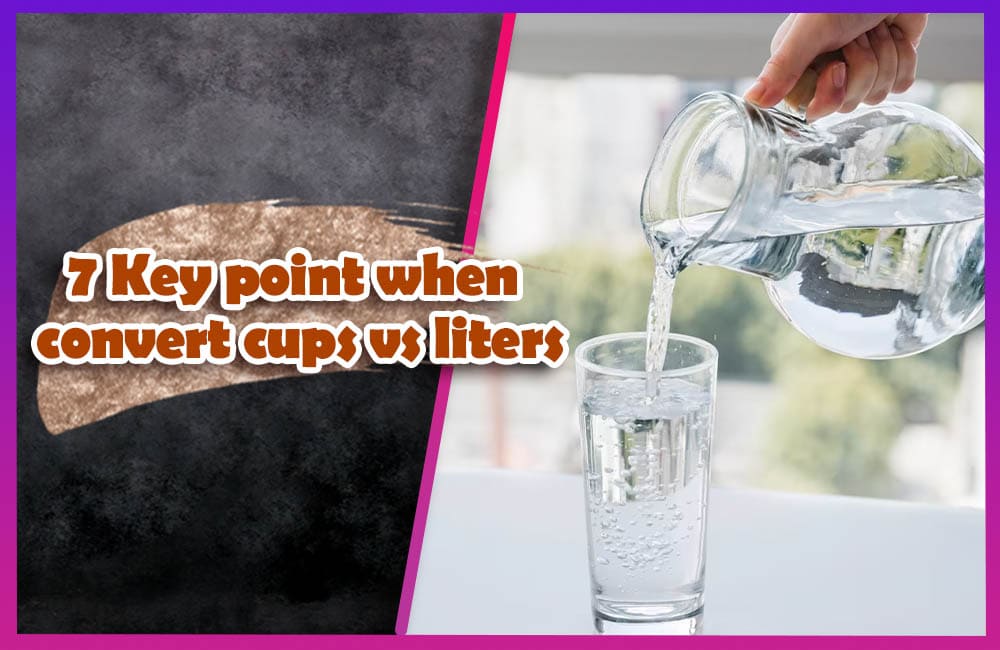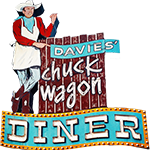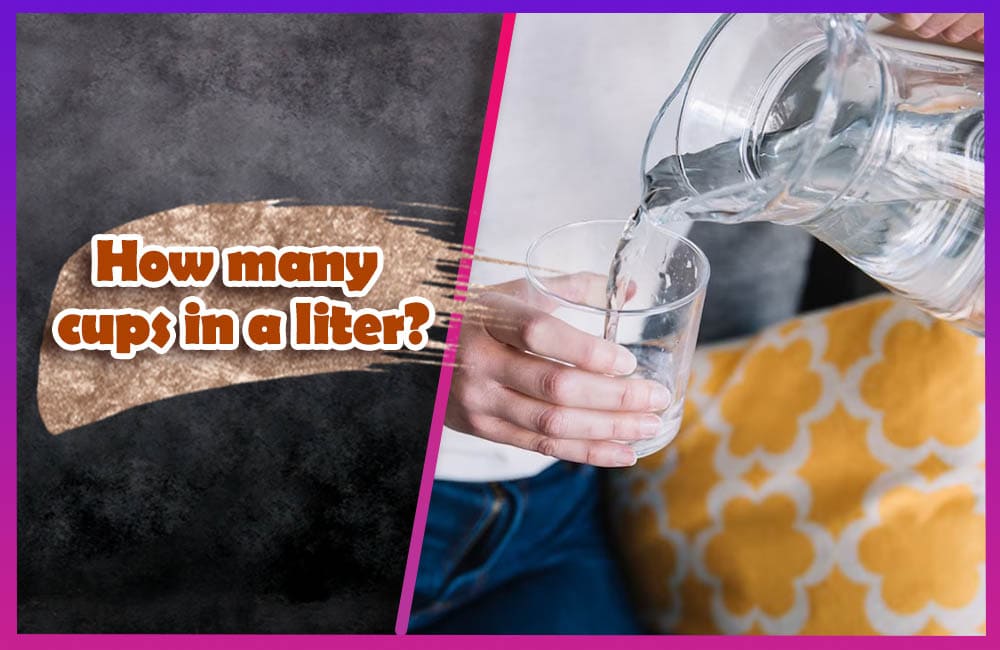How many cups in a liter? Have you ever looked at a nutrition label for the food you’re about to buy and hesitated when trying to work out the serving size?
If so, it’s likely because of confusion surrounding the various measurements we use in everyday life; things like teaspoons, tablespoons, cups and liters.
In particular, many people are confused over how to convert between cups and liters. After all, one is an Imperial measurement while the other is metric—so what’s the answer?
Let’s learn exactly how many cups in a liter—plus tips on how to easily calculate cup-liter conversions any time you need them.
What Is a Cups?
Table of Contents
Cups (measure) are a type of unit of measurement used to measure the volume or capacity of food products, beverages and other liquids.
The cup is often used for measuring ingredients for recipes and as such has become a very popular unit of measurement in cooking.
History
The origin of the cup as a unit of measure can be traced back to ancient Mesopotamia, where it was known as the gur or kor in Sumerian and Akkadian language respectively.
In classical antiquity, the Greek word choinix was also used to refer to one-eighth of a congius, which is equivalent to one-twelfth of an English pint (which itself is equal to two cups).
In the modern English system of measurement, a cup is equal to 8 ounces, or 237 milliliters. In comparison, a teaspoon contains 4.93 milliliters while a tablespoon holds 14.79 milliliters.
Use
Cups (measure) are commonly used in cooking and baking recipes to measure out specific amounts of ingredients needed for the recipe such as flour, sugar, butter and other liquids like oil and milk.
It is also popularly used to measure out gelatin desserts, cooked cereals and rice dishes that use liquid measurements for accurate results when preparing meals.
Example Measurement
1 Cup = 8 Fluid Ounces = 237 Milliliters
Popularity
Cups (measure) have become increasingly popular in recent years due to their ease of use, accuracy and convenience.
They are a particularly popular tool for measuring out ingredients in baking recipes due to the fact that they provide an exact measurement of the ingredient needed.
As such, they have become an essential part of any home kitchen or commercial restaurant’s recipe selection.
What Is a Liter?
Liter (L) is a unit of volume measurement that is commonly used in the metric system. One liter is equal to 1,000 cubic centimeters or 0.001 cubic meters.
It is also equal to 33.814 fluid ounces or 2.11 US pints. The abbreviation for liter is ‘L.’
History Of Liter Measurement
The term ‘liter’ was first used in 1793 when France proposed their new metric system which was based on decimals instead of the traditional French units at the time.
In this system, one liter was defined as the volume of one kilogram of pure water held at a pressure of one atmosphere and at a temperature of 4° Celsius, which is roughly equivalent to 0.001 cubic meter or 1,000 cubic centimeters.
Uses Of Liter Measurement
The liter is used as a measure of volume for many everyday items such as milk and soda as well as large-scale industrial container sizes.
It is also used to measure the capacities of automobile engines and fuel tanks, water heaters, air conditioners, and refrigerators.
In addition, liter can be used to measure capacity of balloons and blimps.
Examples Of Liter Measurement
A liter can be illustrated by many common objects in our daily life:
• A gallon (3.78 liters) of gasoline will fill a typical car’s gas tank
• A 2-liter bottle of soda can contain up to 8 cans worth of liquid
• A standard water bottle may hold 0.5 liters
• An Olympic-size swimming pool contains about 2 million liters of water
• A tanker truck can haul as much as 50,000 liters of fuel
• A liter of paint will cover an area of 10 square meters with two coats.
Popularity Of Liter Measurement
The popularity and convenience of the liter has made it a widely used unit in many countries around the world.
This metric system is used in most European countries, as well as parts of Latin America, Africa, Asia, and Oceania.
The United States does not use the liter for official measurements but it is often used in the food, beverage and automotive industries.
How many cups are in a liter – In US, Metric, Imperial
US System:
In the US system of measurement, 1 liter is equivalent to 4.2267528377 cups. This conversion factor is based on the definition of the US cup, which is equal to 236.5882365 milliliters. Therefore, to convert liters to cups in the US system, we use the following formula:
Number of cups = Number of liters x 4.2267528377
For example, if you have 2 liters of milk and you want to know how many cups it is, you can use the formula as follows:
Number of cups = 2 x 4.2267528377 = 8.4535056754 cups
Therefore, 2 liters of milk is equivalent to 8.4535056754 cups in the US system of measurement.
Metric System:
In the Metric system, 1 liter is equivalent to 4 cups. This conversion factor is based on the definition of the Metric cup, which is equal to 250 milliliters. Therefore, to convert liters to cups in the Metric system, we use the following formula:
Number of cups = Number of liters x 4
For example, if you have 3 liters of water and you want to know how many cups it is, you can use the formula as follows:
Number of cups = 3 x 4 = 12 cups
Therefore, 3 liters of water is equivalent to 12 cups in the Metric system of measurement.
Imperial System:
In the Imperial system of measurement, 1 liter is equivalent to 3.519507972 cups. This conversion factor is based on the definition of the Imperial cup, which is equal to 284.131 milliliters. Therefore, to convert liters to cups in the Imperial system, we use the following formula:
Number of cups = Number of liters x 3.519507972
For example, if you have 1.5 liters of oil and you want to know how many cups it is, you can use the formula as follows:
Number of cups = 1.5 x 3.519507972 = 5.279261958 cups
Therefore, 1.5 liters of oil is equivalent to 5.279261958 cups in the Imperial system of measurement.
In summary, the number of cups in a liter depends on the system of measurement being used.
In the US system, 1 liter is equivalent to 4.2267528377 cups, in the Metric system, 1 liter is equivalent to 4 cups, and in the Imperial system, 1 liter is equivalent to 3.519507972 cups.
Difference between Liquid cups vs dry cups when convert to liter?
Liquid cups and dry cups are two different measurements used in the culinary world.
While liquid cups are used to measure the volume of liquids, dry cups are used to measure the volume of dry ingredients such as flour, sugar, or spices.
When it comes to converting these measurements to liters, there is a slight difference in the formulas used due to the varying densities of the ingredients.
Convert liquid cups to liter
The formula to convert liquid cups to liters is fairly straightforward. One cup is equal to 0.2366 liters, which means that to convert X cups to liters, you would multiply X by 0.2366.
For example, if you want to convert 3 cups of water to liters, you would multiply 3 by 0.2366, which equals 0.7098 liters.
Convert dry cups to liter
On the other hand, when converting dry cups to liters, the formula requires an additional step because the density of dry ingredients varies.
The conversion factor for dry cups is 0.2366 liters per cup, but this needs to be adjusted based on the density of the ingredient.
The density of an ingredient is measured in grams per milliliter (g/ml), and to convert from cups to liters, you need to know the weight of one cup of the ingredient in grams.
For example, let’s say you want to convert 3 cups of all-purpose flour to liters. The density of all-purpose flour is around 0.57 g/ml.
One cup of all-purpose flour weighs approximately 120 grams, so 3 cups would weigh 360 grams. To convert this weight to liters, you would divide it by the density of the flour:
360 grams / 0.57 g/ml = 631.57 ml
To convert milliliters to liters, you would divide by 1000:
631.57 ml / 1000 = 0.6316 liters
Therefore, 3 cups of all-purpose flour is equal to 0.6316 liters.
Here are a few more examples:
Converting 2 cups of granulated sugar to liters:
The density of granulated sugar is around 0.85 g/ml. One cup of granulated sugar weighs approximately 200 grams, so 2 cups would weigh 400 grams.
400 grams / 0.85 g/ml = 470.59 ml
470.59 ml / 1000 = 0.4706 liters
Therefore, 2 cups of granulated sugar is equal to 0.4706 liters.
Converting 4 cups of milk to liters:
One cup of milk is equal to 0.2366 liters, so 4 cups would be:
4 x 0.2366 = 0.9464 liters
Therefore, 4 cups of milk is equal to 0.9464 liters.
Converting 1.5 cups of vegetable oil to liters:
The density of vegetable oil is around 0.92 g/ml. One cup of vegetable oil weighs approximately 218 grams, so 1.5 cups would weigh 327 grams.
327 grams / 0.92 g/ml = 355.43 ml
355.43 ml / 1000 = 0.3554 liters
Therefore, 1.5 cups of vegetable oil is equal to 0.3554 liters.
| Liters | Cups | Pints | Quarts | Gallons | Tablespoons | Teaspoons |
|---|---|---|---|---|---|---|
| 1 | 4.2268 | 2.1134 | 1.0567 | 0.2642 | 67.628 | 202.884 |
| 2 | 8.4536 | 4.2268 | 2.1134 | 0.5283 | 135.256 | 405.768 |
| 3 | 12.6803 | 6.3401 | 3.1701 | 0.7925 | 202.884 | 608.652 |
| 4 | 16.907 | 8.4536 | 4.2268 | 1.0567 | 270.512 | 811.536 |
| 5 | 21.1338 | 10.5669 | 5.2834 | 1.3209 | 338.14 | 1,014.42 |
| 6 | 25.3606 | 12.6803 | 6.3401 | 1.585 | 405.768 | 1,217.304 |
| 7 | 29.5874 | 14.7936 | 7.3968 | 1.8492 | 473.396 | 1,420.188 |
| 8 | 33.814 | 16.907 | 8.4536 | 2.1134 | 541.024 | 1,623.072 |
| 9 | 38.0408 | 19.0203 | 9.5103 | 2.3776 | 608.652 | 1,825.956 |
| 10 | 42.2676 | 21.1338 | 10.5669 | 2.6417 | 676.28 | 2,028.84 |
Table conversions volume measurements in the US (Table B)
| Cups | Liters | Pints | Quarts | Gallons | Tablespoons | Teaspoons |
|---|---|---|---|---|---|---|
| 1/4 | 0.059 | 0.118 | 0.029 | 0.007 | 3 | 9 |
| 1/3 | 0.079 | 0.156 | 0.039 | 0.01 | 5.33 | 16 |
| 1/2 | 0.118 | 0.236 | 0.059 | 0.015 | 8 | 24 |
| 2/3 | 0.158 | 0.313 | 0.078 | 0.02 | 10.67 | 32 |
| 3/4 | 0.177 | 0.352 | 0.088 | 0.022 | 12 | 36 |
| 1 | 0.236 | 0.473 | 0.118 | 0.03 | 16 | 48 |
| 2 | 0.473 | 0.946 | 0.236 | 0.06 | 32 | 96 |
| 3 | 0.709 | 1.419 | 0.355 | 0.089 | 48 | 144 |
| 4 | 0.946 | 1.893 | 0.473 | 0.119 | 64 | 192 |
| 5 | 1.184 | 2.366 | 0.591 | 0.148 | 80 | 240 |
| 6 | 1.421 | 2.839 | 0.709 | 0.177 | 96 | 288 |
| 7 | 1.659 | 3.312 | 0.828 | 0.207 | 112 | 336 |
| 8 | 1.896 | 3.785 | 0.946 | 0.237 | 128 | 384 |
| 9 | 2.134 | 4.258 | 1.065 | 0.266 | 144 | 432 |
| 10 | 2.271 | 4.731 | 1.184 | 0.296 | 160 | 480 |
7 Key point when convert cups vs liters

Know the conversion factor:
As mentioned, the conversion factor between cups and liters is approximately 0.2366.
This means that to convert from cups to liters, you should multiply the number of cups by 0.2366.
To convert from liters to cups, you should multiply the number of liters by 4.227.
Use the correct measuring tools:
When measuring ingredients, it’s important to use the correct measuring cups or spoons for the job.
Liquid measuring cups are designed to be used with liquids and have a spout for pouring. Dry measuring cups are designed for measuring dry ingredients and are often designed to be filled to the brim and leveled off with a straight edge.
Using the wrong type of measuring cup can result in inaccurate measurements.
Be consistent with units:
When doing conversions, it’s important to be consistent with units.
For example, if you are given a recipe that uses liters, but you only have measuring cups, you will need to convert liters to cups.
Conversely, if you are given a recipe that uses cups, but you only have a measuring jug in liters, you will need to convert cups to liters.
Understand the density of the ingredient:
Different ingredients have different densities, meaning that a cup of one ingredient may not weigh the same as a cup of another ingredient.
For example, a cup of flour weighs less than a cup of sugar.
When converting between cups and liters, it’s important to take into account the density of the ingredient you are measuring.
Use a kitchen scale for accuracy:
For the most accurate measurements, it’s a good idea to use a kitchen scale.
This is particularly important when measuring dry ingredients like flour or sugar, as the weight can vary depending on how densely packed the cup is.
By using a kitchen scale, you can ensure that you are using the exact amount of each ingredient required for the recipe.
Round appropriately:
When doing conversions, it’s important to round appropriately to avoid overly precise measurements.
For example, if a recipe calls for 1.5 cups of flour and you are converting this to liters, it would be appropriate to round this up to 0.355 liters.
Trying to use a more precise measurement, such as 0.354882 liters, is not necessary and can make the recipe more difficult to follow.
Check your work:
Finally, it’s always a good idea to double-check your conversions to ensure that you have the correct amount of each ingredient.
This can be particularly important if you are making a large batch of a recipe or if you are making a recipe for the first time.
By double-checking your work, you can avoid any costly mistakes and ensure that your dish turns out perfectly.
Read more:
How many ml in a gallon: Great notes to remember.
How Many Water Bottles Should I Drink a Day?
How many tablespoons in 1/3 cup
How many tablespoons in 1/4 cup
6 Important applications of liter and cups in daily life
1. Measuring liquid ingredients:
For many recipes, it is necessary to measure out exact amounts of liquid ingredients such as water, milk and liquids like oil and vinegar.
When measuring these ingredients, it is important to use the correct measuring cups or jugs in liters.
This ensures that you are using the right amount of each ingredient for your recipe.
2. Measuring dry ingredients:
Dry ingredients such as flour, sugar and grains need to be measured accurately too. In this case, it is best to use measuring spoons or a kitchen scale in order to get an accurate measurement.
The measurements should typically be given in both cups and liters so that they can easily be converted if needed.
3. Estimating volume:
When cooking a dish, it is often necessary to quickly estimate the volume of ingredients that you have.
For example, when making soup, it may be necessary to gauge how many liters of broth or stock are needed.
Estimating in liters can help ensure that you use the correct amount of ingredients for any given recipe.
4. Calculating nutrition facts:
Accurately measuring out food portions is an important part of understanding and managing your nutrition.
When calculating nutrition facts, measuring cups and spoons should be used so that portion sizes can be accurately determined.
This information can then be converted into liters for easy record keeping purposes.
5. Understanding packaging labels:
Many packaged foods come with nutritional labels which tell you the amount of each ingredient or nutrient per serving size.
These labels are given in terms of cups and liters, so it is important to understand how to convert between these measurements when calculating your intake.
6. Adjusting recipes:
When adapting a recipe for a different sized dish, converting between liters and cups can be helpful.
For example, if you want to double the servings of a dish but only have one measuring jug in liters, you will need to use conversion tables to ensure that you are using the correct amounts of ingredients.
This helps to ensure that recipes come out as intended even with changes in portion size.
FAQs about how many cups in a liter
Q1. How many cups are in a liter?
A1: One liter is equal to approximately 4.22675 cups.
Q2. Can I use other units for measuring ingredients?
A2: Yes, you can also use milliliters, teaspoons, tablespoons and other metric units to measure ingredients when necessary.
Q3. Is it important to check conversions when measuring out ingredients?
A3: Yes, it’s important to double-check your conversions to ensure that you have the correct amount of each ingredient in your recipe. This helps prevent costly mistakes and helps ensure that recipes turn out as intended.
Q4. Can I convert between liters and other ingredient measurements?
A4: Yes, you can use conversion tables to convert between liters and other measurements such as cups and teaspoons.
Q5. What other amounts of ingredients can I measure out in liters?
A5: You can measure out any amount of an ingredient in liters, from small amounts like a teaspoon or tablespoon up to large batches for baking or cooking.
Q6. How do I avoid making mistakes when measuring out ingredients in liters?
A6: Double-check your work after measuring each ingredient with a kitchen scale or measuring spoons to make sure that you have the correct amount of each ingredient before continuing with your recipe.
Q7. Is it necessary to measure out large batches of ingredients in liters?
A7: For large batches, measuring in liters can be beneficial as it is easier to measure out a consistent and accurate amount. This helps ensure that your recipe turns out properly.
Q8. Can I use cups for measuring small amounts of ingredients?
A8: Yes, you can use either cups or spoons for small measurements such as teaspoons or tablespoons.
Q9. How do I convert between liters and other units?
A9: You can find conversion tables online or in cookbooks which will help you convert from one unit to another easily and accurately.
Q10. What are some advantages of measuring ingredients in liters?
A10: Measuring out ingredients in liters is a great way to ensure accuracy and consistency when following recipes. It also helps to make large batches easier to measure accurately.
Q11. Do I need special kitchen tools for measuring in liters?
A11: No, you can use measuring jugs or spoons which are available at most kitchen stores.
Q12. What should I do if my recipe doesn’t list measurements in cups or liters?
A12: If your recipe does not list measurements, then it’s important to make sure that you understand how many tablespoons, teaspoons or milliliters equal the desired amount of each ingredient before proceeding with the recipe.
Q13. Can I convert between liters and ounces?
A13: Yes, you can use conversion tables to easily convert between liters and ounces as well as other units of measurement.
Q14. Is it possible to measure out liquids such as oils and vinegars in liters?
A14: Yes, you can easily measure out any liquid ingredient in a liter using measuring jugs or spoons.
Q15. What tips should I keep in mind when cooking with ingredients measured in liters?
A15: When cooking with ingredients measured in liters, make sure to double-check your conversions beforehand and double-check each ingredient after measuring it out.
This will help to ensure accuracy and consistency in your recipes.
Additionally, always make sure to read through the recipe before beginning so that you understand what is required for each step.
Q16. Are there any disadvantages to measuring ingredients in liters?
A16: The only main disadvantage of measuring ingredients in liters is that it can be a bit more time consuming as you will have to convert from other units if the recipe doesn’t specify measurements in liters.
Additionally, if you are not familiar with metric measurements, then it can be a bit tricky to get used to converting between different units.
However, these minor inconveniences are far outweighed by the advantages of accuracy and consistency that come along with measuring out ingredients in liters.
Q17. Can I measure out ingredients in liters when baking?
A17: Yes, you can measure out any amount of an ingredient in liters for baking.
It is important to make sure that all measurements are as accurate and consistent as possible so that your baked goods turn out perfectly every time.
Additionally, it is best to double-check your work after measuring each ingredient with a kitchen scale or measuring spoons to ensure accuracy.
This will help to ensure that the recipe turns out perfectly each time.
Conclusion about how many cups in a liter
One liter is equal to 4.22675 cups. It is important to always double-check measurements when cooking with ingredients measured in liters to ensure accuracy and consistency.
Additionally, conversion tables can be used to easily convert between different units of measurement for any recipe.
Measuring out ingredients in liters is a great way to ensure accuracy and consistency in all your recipes, so make sure you give it a try!

I’m Leon Todd and my passion for cooking is my life goal. I’m the owner and operator of Davieschuckwagon.com, a website that specializes in providing high-quality cooking information and resources. I love to experiment with new flavors and techniques in the kitchen, and I’m always looking for ways to improve my skills.
I worked my way up through the ranks, taking on more challenging roles in the kitchen. I eventually became a head chef.
Cooking is more than just a job to me – it’s a passion that I want to share with the world.

